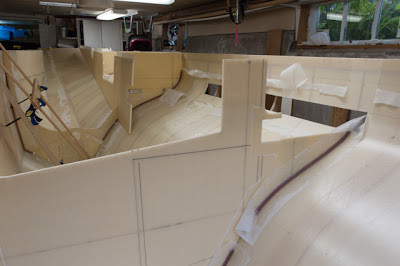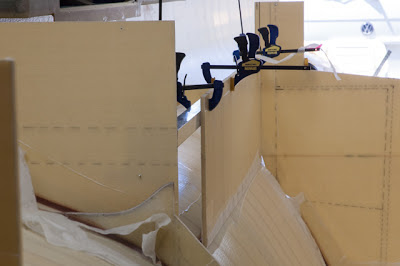Lifting out the first main hull half -- a pretty exciting step (I've probably said this before, its one of the great things about seeing a project take shape). After removing a couple thousand + screws I tried lifting. It was loose in places, but it wasn't going to pop out. I lifted with a come-along from the forward bulkhead, and leveraged along the outer centerboard case, pushed and pulled -- and then it popped!
I think the problem was from the few screws that had penetrated the foam and required removal and filling prior to the glassing (or the one that leaked and I had to take care of during the bagging with 5 minute epoxy). These areas acted like an epoxy screw in the batten. I'll plan on marking them from the outside next time while backing the screws out so I can take care of them individually prior to lifting.

Not being able to lift the hull very far I had to crawl along underneath to remove the screws. Some areas behind the deck and near the keel were a real challenge.

I hadn't been planing on saving most of the battens, so it was an easy choice to start cutting them up when it became easier to do it that way.
Its quite the archeological dig under the forms.

Somehow I think the outer hull is more impressive, even at this rough stage, than the interior. It looks like a boat!

Its an easy two person lift by my brother and I when it comes to weight, but holding on and trying to turn it was a challenge, in more ways than one -- meaning we had a couple of false starts. I measured from keel to cabin top and it appeared that I would be able to make the rotation -- No.
We discovered that the greatest distance was actually from the keel to the gunwale, more height than I had. So I removed the garage door opener off the ceiling, knowing I was going to do that before I brought the boat back in after joining anyway (and I'd hit my head enough while crawling around that it was about time).
(Before removing it from the forms I had placed braces from deck to keel to add support as necessary.)

This time I recruited a few more people (thanks fellow Neighborhood Block Party participants!) and tried again. With this many people everyone felt like they weren't doing anything. But again, so close, but it wan't going to happen.

So we walked it out.

Turned it over . . .

and walked it back in. Easy.
The only concern was placing the glue flange along the bunk and cockpit floor into a prepared groove to protect it during the next step.

We escaped for a short cruise. Five days in the San Juans on my Dad's boat. Amazing to be so close to something so great.

When we returned, I started back filling the seams where necessary and filling the screw holes. Then it was shaping and fairing with the longboard.

I raised the hull onto 2x4's to protect the flange and moved it over onto an outer support so I could see the centerboard in action. I suppose we should call it a sideboard or a portboard. I think it looks great.

Here's how I relieved the hull slightly to fit the front part of the board. Its really a testament to the design and engineering that went into the plans when you see how all the angles come together in the right place with the interior to exterior board transition and the curved hull.













































